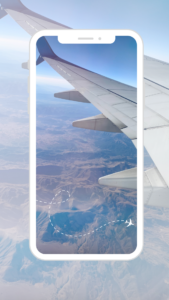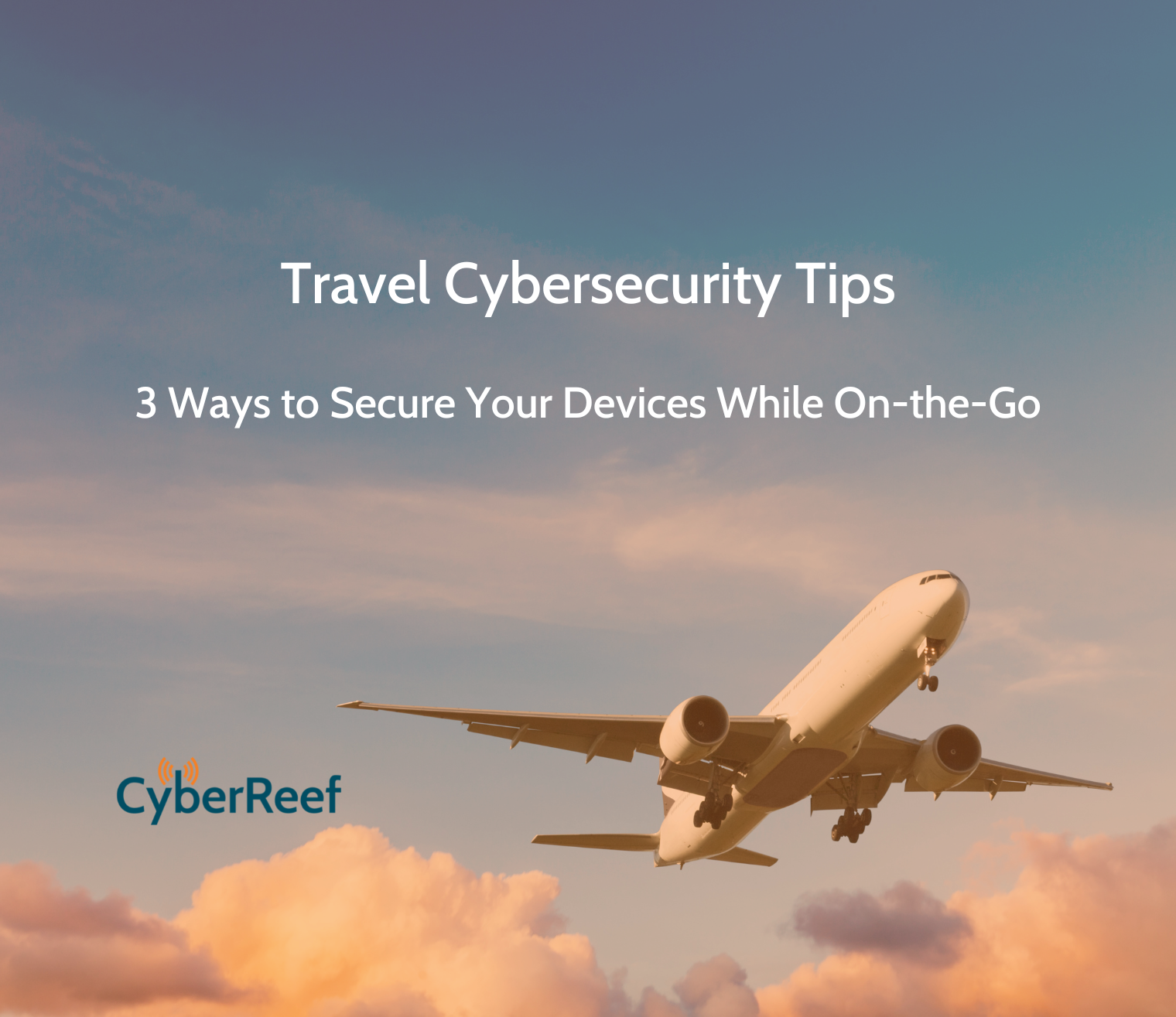Travel Cybersecurity Tips
3 Ways to Secure Your Devices While On-the-Go
 We all travel. It’s likely that over the next fiscal year, you will be in an airport at some point. Those of us who travel for work are likely to be in the airport even more. We all go through the same process: Check your bags, grab your tickets, and wait in the line for TSA to allow us into the main airport. What most people don’t realize is that the security concerns do not stop at the TSA checkpoint. Inside the airport itself, there are a host of attackers just waiting for you to join that airport Wi-Fi with an unprotected device. Travel cybersecurity tips and tricks are something we rarely think about.
We all travel. It’s likely that over the next fiscal year, you will be in an airport at some point. Those of us who travel for work are likely to be in the airport even more. We all go through the same process: Check your bags, grab your tickets, and wait in the line for TSA to allow us into the main airport. What most people don’t realize is that the security concerns do not stop at the TSA checkpoint. Inside the airport itself, there are a host of attackers just waiting for you to join that airport Wi-Fi with an unprotected device. Travel cybersecurity tips and tricks are something we rarely think about.
Let’s crunch some numbers here.
How many devices do you carry when you travel? For me, it’s usually at least two: My phone and my laptop. For the sake of argument, we are going to say the average person has 1.5 devices on them when flying (as I know not everyone carries their laptops if they’re going on vacation or seeing family, but I can guarantee they almost all have a phone). Per the Bureau of Transportation Statistics, the United States carried 674 million passengers around and out of the country by plane in 2021. If we use our 1.5 devices figure, that means over ONE BILLION devices flew with us. That is quite a large number, and most of these devices are likely unsecure.
Getting Connected.
Now let’s touch on that lovely, free Wi-Fi at the airport. Isn’t it great? You don’t have to worry about wasting your cellular data on your phone to stream your shows or play those addictive mobile games. It’s an official Wi-Fi given to us by the airport, right? What can go wrong? Well, I hate to break it to you, but that Wi-Fi isn’t as safe as you might think. Between phishing scams, hackers, honeypots, and simply improperly secured or completely unsecured networks, there are a thousand ways your devices can be attacked while on public Wi-Fi in the airport. They can steal anything from your photos to your bank information, and all you did was simply connect.
All is not lost, however.
3 Travel Cybersecurity Tips.
 Use a VPN. VPNs are virtual private networks that will, once activated, keep your data invisible from the public network. According to Security.org, only 32 million Americans actively use VPNs. This obviously leaves us with a lot of unprotected devices from our numbers above. Why when it seems so simple? VPNs do have their own share of issues you need to be aware of. A VPN, depending on location, can greatly decrease the speed at which your connection runs. My VPN has impacted Zoom calls to where the buffering was unbearable, and I was using a server located less than a hundred miles from where I live. Certain websites will also deny access if you’re on a VPN. They will flag you as unknown and hostile and will not let you in until you turn it off and reload the page. Streaming sites are notorious for this. This makes for a terrible user experience. Depending on where you travel, some countries have made VPNs illegal to use. Be aware of local laws regarding VPNs.
Use a VPN. VPNs are virtual private networks that will, once activated, keep your data invisible from the public network. According to Security.org, only 32 million Americans actively use VPNs. This obviously leaves us with a lot of unprotected devices from our numbers above. Why when it seems so simple? VPNs do have their own share of issues you need to be aware of. A VPN, depending on location, can greatly decrease the speed at which your connection runs. My VPN has impacted Zoom calls to where the buffering was unbearable, and I was using a server located less than a hundred miles from where I live. Certain websites will also deny access if you’re on a VPN. They will flag you as unknown and hostile and will not let you in until you turn it off and reload the page. Streaming sites are notorious for this. This makes for a terrible user experience. Depending on where you travel, some countries have made VPNs illegal to use. Be aware of local laws regarding VPNs.
 Use your cellular connection. The other foolproof option to protect yourself is to use cellular data. With your phone, that’s simply turning off Wi-Fi. For your laptop, hotspots are great. They are fairly inexpensive and can be purchased at just about any technology store. These allow you to bypass Wi-Fi altogether and use an entirely different method of connection. However, cellular networks can be breached as well, and are not always completely secure. Not to mention, if you are using your phone as a hot spot you can quickly use up your personal data plan.
Use your cellular connection. The other foolproof option to protect yourself is to use cellular data. With your phone, that’s simply turning off Wi-Fi. For your laptop, hotspots are great. They are fairly inexpensive and can be purchased at just about any technology store. These allow you to bypass Wi-Fi altogether and use an entirely different method of connection. However, cellular networks can be breached as well, and are not always completely secure. Not to mention, if you are using your phone as a hot spot you can quickly use up your personal data plan.
 Private cellular connection to the rescue. This is where CyberReef comes in – to address the pitfalls of both VPNs and Cellular. MobileWall by CyberReef will put your cellular devices (any device that uses a SIM card, actually) onto a private cellular network that is totally unbreachable by malicious actors. We provide security, visibility, and control into your data that is fully customizable by the end user. Also included in our platform is malware threat protection, so you’ll be safe from ransomware, phishing, and all other forms of attacks. Our data centers, located across the US, will keep you from experiencing speed degradation at any noticeable level. So, with CyberReef, you get the best of both – VPNs and cellular: Quick speeds, security, and peace of mind that your data is safe while traveling. And all with the same experience you would have from home or the office.
Private cellular connection to the rescue. This is where CyberReef comes in – to address the pitfalls of both VPNs and Cellular. MobileWall by CyberReef will put your cellular devices (any device that uses a SIM card, actually) onto a private cellular network that is totally unbreachable by malicious actors. We provide security, visibility, and control into your data that is fully customizable by the end user. Also included in our platform is malware threat protection, so you’ll be safe from ransomware, phishing, and all other forms of attacks. Our data centers, located across the US, will keep you from experiencing speed degradation at any noticeable level. So, with CyberReef, you get the best of both – VPNs and cellular: Quick speeds, security, and peace of mind that your data is safe while traveling. And all with the same experience you would have from home or the office.
My big take a ways. Two things are true of Americans: We like our technology, and we like to travel. Sometimes, however, we don’t take the time to make sure the former is safe while we’re doing the latter. Hopefully these travel cybersecurity tips and tricks can better prepare you next time you have to hop on a plane. Remember, always get to the airport at least two hours early, and please secure those devices.
 PRO CYBERSECURITY TRAVELING TIP
PRO CYBERSECURITY TRAVELING TIP
Turn off your printer and file sharing options on your computer. Hackers can use these to access files on your system if your settings are too trusting. Just to be safe, it is best to turn them off completely while at the airport.
About Kris Madden
A Sales Engineer at CyberReef, Kris Madden is strongly motivated to bring customers into the world of cybersecurity through knowledge and education. Graduating from Baylor with a BBA in Management Information Systems, Kris has the toolset to discuss technical aspects of CyberReef’s products while making them accessible to those who may have no understanding on the subject. Outside of work, you can find Kris reading science fiction, hitting the gym, or watching any form of college athletics that is currently airing on TV.

